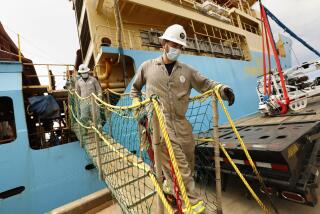Poor Islands See an Undersea Gold Mine : South Pacific: Leaders hope the experts are right and that exploiting the mineral riches will transform their economies, now among the world’s poorest.
- Share via
SUVA, Fiji — For as long as Tongans can remember, oil has oozed from the soil of Tongatapu island in sticky black puddles.
Thousands of miles away, specks of gold appear among the grains of beach sand under the coconut palms of Vanuatu.
Millions of nodules of rare minerals are spread on the sea floor around the Cook Islands.
Geologists believe the South Pacific is a treasure-trove of mineral deposits. Island governments hope the experts are right and that exploiting the riches will transform their economies, now among the world’s poorest.
“We just don’t know enough about what is out there,” said Philipp Muller, head of the South Pacific Applied Geoscience Commission, the regional agency for mapping resources.
“There have been some promising results, but so much is still unexplored. We’ve only just scratched the surface. This is a real frontier for prospectors.”
Most of the island nations are dispersed archipelagoes that subsist on coconuts, fishing and tourism but have economic rights to vast areas beyond their shores.
Kiribati, for example, is 33 coral atolls scattered on both sides of the Equator and International Dateline. Although its total land mass is only 313 square miles, its exclusive economic zone covers 2.2 million square miles.
“It would be marvelous for island countries to have undersea resources found and exploited,” said Ieremia Tabai, a former president of Kiribati who now heads the South Pacific Forum, the main political and economic group in the region.
Muller sees oil as the brightest prospect, even though a 25-year search has met little success, and counts on new exploration technology.
More than a dozen promising sites have been identified just north of Fiji in Bligh Water, named for Capt. William Bligh, who sailed through in a small boat 200 years ago after the Bounty mutineers cast him adrift.
In Bligh Water and other places, geologists believe, oil formed in sediments deposited more than 20 million years ago and is trapped in the porous rock of ancient coral reefs thousands of feet beneath the seabed.
Among other tantalizing mineral prizes are nodules of manganese, copper, nickel and cobalt that formed over millions of years on the ocean floor around the Cook Islands, west of Tahiti.
Such deposits would be worth several fortunes on land, but it is difficult--and so far uneconomic--to go after them 13,000 to 19,000 feet down, where the water pressure is immense.
Technology is being developed, however, and Muller said undersea mining “is just around the corner.”
Researchers from the University of Hawaii plan to test undersea mining equipment next year, at a depth of 5,250 feet.
China, Japan, South Korea and India also are developing techniques.
Undersea mining was tried unsuccessfully in the 1970s, between Hawaii and California. Keith Crook of the university’s Hawaii Undersea Research Laboratory said it will become feasible as demand and prices increase and mineral deposits on land diminish.
He envisions huge floating platforms controlling machines or robots on the sea floor.
The land already has yielded some wealth, notably the oil wells and huge gold and copper mines of Papua New Guinea.
Gold has been mined in Fiji all of this century and there are plans for a huge open-pit copper mine.
More to Read
Sign up for Essential California
The most important California stories and recommendations in your inbox every morning.
You may occasionally receive promotional content from the Los Angeles Times.













